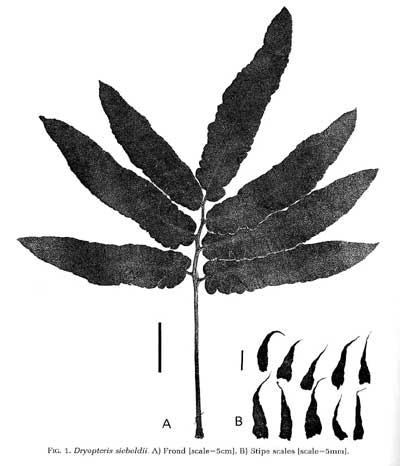| Dryopteris sieboldii | ||
|
Etymology
After Franz Philipp von Siebold, 19th century German botanist, a specialist in plants of Japan.
Description
Rhizome: short-creeping, scales lanceolate to linear, acuminate at apex, brown to blackish brown, 1--1.2 cm long.
Frond: 50 cm high by 40 cm wide, evergreen, somewhat dimorphic, fertile fronds erect, sterile arching, blade/stipe ratio: 3:1 to 1:2. Stipe: straw-colored, dark at base, grooved, scaly at base, vascular bundles: 3-7 in a c-shaped pattern. Blade: 1-pinnate, broadly ovate, papery, hair-like linear scales sparsely persistent on lower surface. Pinnae: 2 to 6 pair, linear, acuminate, round at base, the sterile pinnae wider, slightly crenate at margins, and a similar terminal pinna, all sessile (or lower pinnae short-stalked); veins free, forked. Sori: round, dispersed evenly, indusium: reniform, at a sinus, sporangia: brownish. Culture
Habitat: dry floor of mountain forests.
Distribution: Japan and China.
Hardy to -20°C, USDA Zone 6.
Distinctive Characteristics
the pinnate form is so distinctive that the only confusion would place it as a non-fern
Synonyms
Aspidium sieboldii Van Houtte ex Mett. Lastrea sieboldii Moore Nephrodium sieboldii Hook. Polystichum sieboldii Keys. Pycnopteris sieboldii Moore |
|
|
